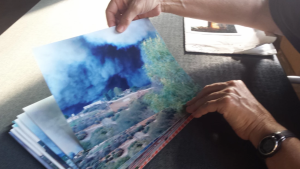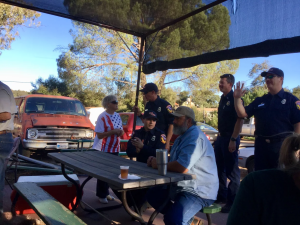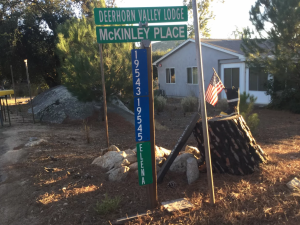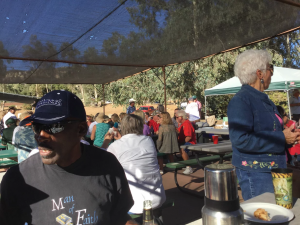
“It was like a warzone. Fire was everywhere.”
By Kendra Sitton
December 13, 2017 (Deerhorn Valley) -- Michelle Grimaldo got out of her car and hugged her mom goodbye on a fiery night in October of 2007. They were in the middle of the road, with flames on both sides, their way blocked by more fire. She called her husband, but they couldn't hear each other, so she just yelled “Get out! Get out! Get out!” into the phone.
“When you say you think you’re going to die, you thought you were going to burn. That was my time,” Michelle said.
Michelle and her mother held onto each other as they witnessed their community in Deerhorn Valley fall victim to the blaze. It felt like forever, but finally Gregg Grimaldo came down with a load of horses and pulled up behind them in the center of the road.
When it looked safe, they drove into an open field and parked. The smoke was intense and they wrapped sheets over their faces. They sat there and watched everything burn.
“It was horrible, and I just remember three water trucks came and parked around us as the sun came up and I felt like it was the cavalry. I felt like we were going to live at this point,” Michelle said.
The sun began peeking over the mountain through the blackened sky, revealing what they already knew: everything was on fire. They stood by as the Harris Fire tear through Jamul. Eventually, they were told it was safe enough to leave, and they went to another friend’s house across from Steele Canyon High School. The Grimaldos and other families would stay there for the next few days, waiting on word about whose house had made it and whose hadn’t.
Michelle described Jamul as a warzone. The fire tore through, destroying everything living and man-made until all that was left were monochromatic forms of rocks and melted fences— a small monument to the vibrant life which once filled her beloved Deerhorn Valley.
 Ten years ago, even one of the firefighters assigned to the area was surprised by the blaze’s speed as he moved from station to station. In the time he drove, the fire spread up to 30 miles, beating him to his destination.
Ten years ago, even one of the firefighters assigned to the area was surprised by the blaze’s speed as he moved from station to station. In the time he drove, the fire spread up to 30 miles, beating him to his destination.
The Harris Fire was one of several blazes ripping through Southern California in the arid October of 2007. Of the Witch Creek and Guejito fires, Harris was the most deadly— claiming eight of the 10 lives lost. Dozens more were injured. At the end of its reign, the Harris fire destroyed 90,000 acres and 253 homes.
Wildfires are not unusual for Jamul, but this one exploded into a raging inferno. During the typical brushfire, the Grimaldos had a tradition of sitting at their back porch to watch the blazes and wave at the aircraft who came to put it out.
The Harris Fire began on Sunday, Oct. 21 in Potrero, near the border of Mexico. By the 23rd, it had reached Chula Vista. Throughout San Diego, the firestorms triggered 500,000 evacuations. All of Jamul was evacuated. A woman from another valley over said when she evacuated, the smoke was so dense it seemed as dark as driving at midnight when it was only 12 p.m.
As was tradition, the Grimaldos watched the fire from their home when it first flared nearby, but this time it got closer than before. Just to be safe, Michelle decided to pack up all the animals: five horses, four dogs, two cats, a couple guinea pigs and birds. Two of the horses were rescues from Canada who weren’t trailer trained. A team of neighbors gathered to get the last one inside the trailer. Before the Grimaldos left, Michelle made the firefighters who stopped in hot chocolate. They told her they were confident her house would be fine. This was just a precaution in case the wind switched directions. She hugged each one of them and thanked them for saving her house.
They went a mile away up a one-way dirt road to stay at the Crossmans, along with 20 people and 30 horses. Michelle’s mother lived with them and had back problems, so they had to bring a special recliner for her to sleep in. Despite the full house, people finally settled in to sleep. In the middle of the night, someone woke up and ran down the hallway to get everyone up. The Grimaldos’ second evacuation began; this one more frightening than the last. They could see the fire out the window on the hill.
The families had Michelle leave first because of her mom. Even in her rushed exit, she stopped along the way to open gates and let horses out. On the dirt road, the fire chief came up and demanded what they were still doing there. Michelle asked what he meant and he answered they weren’t supposed to be there. She said nobody told them, they just saw the fire. He told them to go to the fire station. In the chaos, she called back to the house, where they were still gathering animals, to tell them to get out now.
 On top of the toy hauler Michelle was driving perched her mom’s recliner. “It was like the Beverly Hillbillies with the grandma in the back,” she laughed. Flames began shooting over the truck as she tried to escape. “And the only thing I could think of was that stupid chair was going to catch on fire and we were going to go up in flames.”
On top of the toy hauler Michelle was driving perched her mom’s recliner. “It was like the Beverly Hillbillies with the grandma in the back,” she laughed. Flames began shooting over the truck as she tried to escape. “And the only thing I could think of was that stupid chair was going to catch on fire and we were going to go up in flames.”
They made it to the fire station, parked in the road, and said what they expected would be their final goodbyes. However, the fire tore around them and it was eventually safe to evacuate elsewhere.
The last hotspot was finally extinguished on Nov. 16. To assess the damage and prevent the next fire, San Diego County assembled a Grand Jury. Their 2008 report revealed troubling trends. Fire seasons were two months longer than in the 1970s, and claimed 6.5 times more land. The report emphasized San Diego had not learned from the 2003 Cedar Fire, and offered several recommendations on how to better prepare. Some were immediately followed, like brush management. For instance, private property was inspected for clearings around buildings, albeit not as thoroughly as each residence is reviewed now. However, county and state property rarely faced the same code enforcement. In response, San Diego’s then-Mayor Jerry Sanders aggressively cleared brush in the city’s canyons.
The Grand Jury also stated fire services were underfunded and didn’t adequately cover the area, pushing up response times to emergencies. They recommended complying with federal fire standards, as well as consolidating all of the local fire stations under one head. Soon after, many unincorporated areas came under the command of San Diego County Fire Authority, with Julian as the only holdout. It still maintains its own volunteer fire station.
The Grand Jury reviewed fire responses again in 2015 and said the area had made great strides, but still has work to do. In a commentary, Supervisor Dianne Jacob said, “It’s no stretch to say that our region today has more locally based wildland firefighting resources in place than anywhere in the nation.” She summarized the advancements in fire services, but also urged San Diegans to stay vigilant, especially after witnessing the recent tragedy in Northern California, and now in L.A. and northern San Diego.
After the vigil on the fire station road, the Grimaldos made it safely to another friend’s house. The calls about who had lost homes began. The Grimaldos were given the news their house survived, but a day later a new shift lead checked and it was gone. They called their neighbor to say his home was okay, but then a day after that ashes went through his roof and it went down. Michelle recalled, “I had to call them back to say I’m so sorry, your house has burned down.”
The Grimaldos’ house was at the base of two mountains. “The firemen, there was nothing they could do. It was more dangerous for them to stay and try to save the house,” Gregg said. Michelle remembered how confident she and the firefighters had been that the house would be fine. “I know they must have felt like crud. They must have felt so horrible because I just got through hugging everybody and saying how much I appreciated them. I know they felt bad, and that killed me,” she said.
They spent the next days glued to the news. The fire continued to grow, and they began to worry they would need to evacuate for a third time. Michelle told Gregg if they had to leave, they were going to sit in the ocean until it was over because she couldn’t do it again.
Channel 8 broadcast the first good news for the waiting families. A reporter stood at the front of the Crossmans’ house, where so many had initially evacuated to. “The anchor says thank you Mark and Linda for the clearing, we feel really safe,” remembered Michelle, “Everyone in the house started screaming and hugging. Happy that their house was still standing and ok. It was such a big relief.”
 This October, many residents of Deerhorn Valley gathered for a 10-year-anniversary party. It was a time of dancing, live music, shared food, and shared memories. Members of the local fire station joined the festivities. The residents expressed how much they had seen fire responses change in the decade since their lives were torn apart. “Fire services are much better prepared now than in 2007,” said resident Cindy Schleieder. The sentiment was shared by many. Michelle said, “I think if the County learned anything, It’s response time. Any time, even if it’s something small, it’s like an attack force goes out there.” They feel fire services work to ensure a one-acre blaze never reaches the massive levels of the Harris or Cedar fires.
This October, many residents of Deerhorn Valley gathered for a 10-year-anniversary party. It was a time of dancing, live music, shared food, and shared memories. Members of the local fire station joined the festivities. The residents expressed how much they had seen fire responses change in the decade since their lives were torn apart. “Fire services are much better prepared now than in 2007,” said resident Cindy Schleieder. The sentiment was shared by many. Michelle said, “I think if the County learned anything, It’s response time. Any time, even if it’s something small, it’s like an attack force goes out there.” They feel fire services work to ensure a one-acre blaze never reaches the massive levels of the Harris or Cedar fires.
The Public Information Officer of Cal Fire’s Monte Vista headquarters contends with this assessment. Isaac Sanchez said the policies haven’t changed over the past decade about how many units to deploy. It has always been a system based on weather: in dry and hot conditions more trucks respond, and in low-risk conditions less people respond to a reported fire. “It’s all based on which response level we are in,” said Sanchez, “If it’s a hot, dry day we would be in high dispatch. So at that point, you’d get in the area of 10 fire engines on the initial dispatch, but if it’s January and it rained yesterday, you might only get two engines.”
The Harris Fire began on a day with the worst of all conditions: heat, low humidity, and Santa Ana winds up to 100 miles an hour--hurricane force. Sanchez said the biggest change since 2007 is in the coordination with other departments in the city, as well as with state and federal agencies. Officials are more likely to cooperate and send resources back and forth. “It’s more of a regional preparedness than one particular fire department,” Sanchez said, “It’s a recognition by all departments in the County that it’s not an East County problem or a backcountry problem, it’s a community problem. A county-wide problem.”
 While some County policies have changed since 2007, experts fear residents are becoming more complacent. In a survey from the county Office of Emergency Services, only half of residents are prepared to evacuate their homes within 15 minutes of a crisis. That’s down from 74% in the immediate aftermath of the wildfires a decade ago. For those in Deerhorn Valley, fire is a fear not forgotten.
While some County policies have changed since 2007, experts fear residents are becoming more complacent. In a survey from the county Office of Emergency Services, only half of residents are prepared to evacuate their homes within 15 minutes of a crisis. That’s down from 74% in the immediate aftermath of the wildfires a decade ago. For those in Deerhorn Valley, fire is a fear not forgotten.
“It never leaves you,” said Gregg. If he is in town and sees a gray column of smoke, he often returns home to prepare just in case they need to evacuate. His neighbor has a scanner to keep them informed. He is part of Facebook groups which alert each other if someone sees smoke. Everyone calls emergency services if they smell smoke. They look for the source and will update the group when firefighters respond.
“Everyone’s on it now, and everyone informs everyone else,” Gregg Grimaldo said.
Sandra Ignoci is similarly prepared. She still has her suitcase from 2007 packed. “We’ve all been through so much,” Ignoci said, “Everyone is nervous around smoke.” She recalled a recent swap meet where people saw smoke in the distance. Everyone packed up quietly and left.
Unlike during the Harris Fire, the Grimaldos have a list of stuff to grab when they evacuate. Many things are also inside fireproof safes.
Ignoci didn’t lose a home during the fire, but people next door did. “Why are we saved and they lost?” she remembers asking when she returned home. The survivor’s guilt has passed on to an ironic sort of humor. Another resident, Gail, pointed out she lost everything except a barn full of hay, while others just lost their barns. That the fire would leave a building full of dry kindling untouched demonstrates its illogical and unpredictable path.
It still managed to destroy the Grimaldos’ house, along with 252 other residential structures. For the next four weeks, Michelle woke up every morning and cried. She went to the Red Cross and cried when she saw brand-new pillows. Nothing was standing in her house. Even cement exploded in the heat. She had nothing except a toothbrush and a pillow.
“People always say, oh you know, you’re lucky, at least you got your animals out. It's true but, my entire life went up in smoke… every memory. You have it in your brain, but pretty soon you’re getting old and not remembering it without a picture anymore,” Michelle said with emotion tingeing her voice. Even today there are things she will wonder where they are and then realize they’re gone. “The rest of your life you’ll be remembering, oh nope, nope, that was in 2007.”
After days of grief and waiting on the news, the evacuees were allowed to return and see what was left. The National Guard was deployed then. “Driving up to the house, it looked like the moon. It was black. It was crater-like. It was just tarred black and rocks. All I could think about is this is what it’s like to be in a war,” Michelle said.
They were given hazmat suits and a small sifter to search through the ash for anything left. That’s what they were supposed to find their life in.
The couple could easily list the things they miss the most: a picture of horses Gregg stamped into a copper sheet in high school, wedding pictures, pictures of their ancestors, Michelle’s collection of silver coins. “You look back and it doesn’t matter, but you look back and we had beautiful, one-of-a-kind Indian artifacts,” said Michelle. Things which were unique and irreplaceable, things they wished they had grabbed.
In the ashes, the Grimaldos found three things: a coyote sculpture which was fired in a kiln so had already survived thousands of degrees, the Indian rug it was standing on, and a welcome sign.
Another fire survivor, the Chavez family, feels the grief in seasons. Rosa Chavez misses her Christmas ornaments, which were hand-made treasures created over a lifetime. She feels their loss anew each time the season’s preparations begin. Even so, she hosts a New Year’s Party in the neighborhood with her house fully decked out, in what others describe as spectacular decorations.
Compared to many others, the Grimaldos’ process of getting insurance money, permits, and rebuilding was relatively smooth. Gregg, a contractor, designed their dream home. There was no hesitation about whether they would move back to the fire-prone area. Michelle said they loved the people and loved where they lived. They couldn’t see themselves somewhere else.
They learned to cope with the loss. “You have to find funny things to say about it. My thing was, hey, you ever want to go through your garage— just burn down the house!” joked Michelle.
Michelle has a mantra: out of the ashes comes beauty. The two see it in their community, which is now closer than ever.
 Gregg said, “A lot of the people that live there have been there for years and years, and understandably they’re not too accepting to new people coming in because they don’t know what kind of people they are. A tragedy like this, everyone’s looking for help. It doesn’t matter who they are, what race they are, whatever nationality they are, they’re just looking for help. Things like that bring people together, tighter.”
Gregg said, “A lot of the people that live there have been there for years and years, and understandably they’re not too accepting to new people coming in because they don’t know what kind of people they are. A tragedy like this, everyone’s looking for help. It doesn’t matter who they are, what race they are, whatever nationality they are, they’re just looking for help. Things like that bring people together, tighter.”
According to Michelle, new people who move in and attend Deerhorn Valley’s football parties or other functions always say they’ve never lived in a community like this one. “You can live in the city, live next to 55 people in apartments and not know your next door neighbor. We know people miles away because they’re from Jamul, because they live in Deerhorn Valley,” Michelle said. Now, everybody watches out for everybody.
“If you’re here for any amount of time you know it’s special. You can’t leave. There’s something special about the people and place — we all went through it together,” said Louis Chavez.
The community united to help others struggling. The Chavez family lived in their motor home on a neighbor’s property. Fundraisers were held for the uninsured owner of property which once housed the community center.
 The experience has also given the Grimaldos more understanding of others. They watched the hurricanes sweeping through the southern United States with a feeling like they knew what people were going through. Michelle said, “You can look and say wow, that’s really bad, but until you’re there you don’t understand the magnitude of it. Nobody else can understand unless you’ve been through it.”
The experience has also given the Grimaldos more understanding of others. They watched the hurricanes sweeping through the southern United States with a feeling like they knew what people were going through. Michelle said, “You can look and say wow, that’s really bad, but until you’re there you don’t understand the magnitude of it. Nobody else can understand unless you’ve been through it.”
Gregg agreed, “You see it on TV of other people going through that thing, but you really don’t know it, experience it, or feel the emotion, until you go through it yourself.”
The face of Deerhorn Valley changed after the fires. Many people who had lived there for ages didn’t have insurance and couldn’t afford to rebuild. A once-stable community soon heralded in many newcomers. Others are just beginning to rebuild 10 years later, as the community spreads through Jamul’s hills.
 The community center has never been rebuilt, but the property is still open to guests. Picnic tables and a canopy spread over a concrete foundation for the memorial party. Deerhorn Valley commemorated the 10-year-anniversary of the Harris Fire on a place which hadn’t recovered fully, but people could still enjoy. Grimaldo thinks the community’s next project will be to raise funds and rebuild the community center so they have an official place to gather together.
The community center has never been rebuilt, but the property is still open to guests. Picnic tables and a canopy spread over a concrete foundation for the memorial party. Deerhorn Valley commemorated the 10-year-anniversary of the Harris Fire on a place which hadn’t recovered fully, but people could still enjoy. Grimaldo thinks the community’s next project will be to raise funds and rebuild the community center so they have an official place to gather together.
“It’s a community unlike any other,” Michelle concluded.









Recent comments